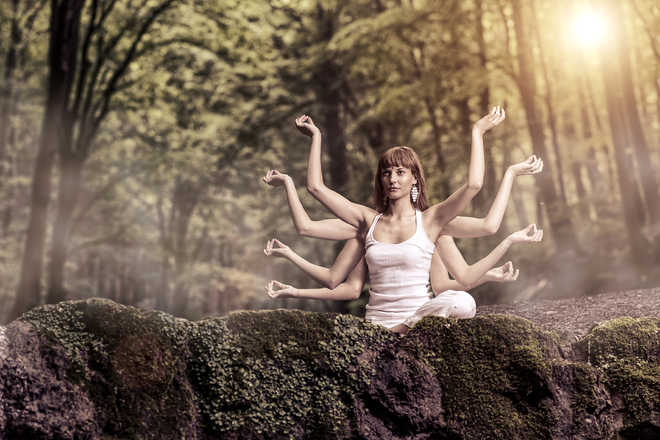Samyukta hasta mudras: Spirituality of gestures
Dr Satish K Kapoor
A mudra stands for symbol, seal or gesture, with a viniyoga, special usage. While some mudra-s engage the entire body, others require only hands and fingers. Samyukta hasta mudra-s, involving both hands simultaneously, are as much used in classical dance, drama and iconography, as in yoga, tantra and spiritual practices. The number of such mudra-s in ancient texts varies from 13 (Bharata Muni) to 24 (Acharya Nandikeshvara) or more. Here are a few double-hand gestures, with spiritual implications.
Anjali mudra
Anjali is divine offering. Anjali mudra, also called atmanjali or hridyanjali, is used as a form of greeting by joining the palms of hands, in front of the heart, face, or crown of head. The fingers point skyward. While making salutation to a deity or its form. Anjali mudra is offering one’s lower self to the higher self during meditation. This mudra activates Anahata chakra or heart-centre in the subtle body.
Kapota mudra
Kapota or dove is a symbol of peace. Kapota mudra is the same as Anjali mudra, except that hands are joined in a cupped position – palms touching at the tips of fingers and at the base. It indicates, acceptance, obedience or submission; and also, fragility or subtlety. It is accompanied by the traditional Hindu greeting, Namaste, meaning, ‘I bow to the divine within you.’
Karkata mudra
Karkata means a crab or a crane. Karkat mudra is formed by entwining fingers of both hands while keeping the thumbs outstretched. In natyashastra, it denotes many things – stretching of limbs, exposing the midriff, bending a bough, arrival of people, or blowing the conch shell. During meditation, Karkat mudra symbolizes coordination between five jnanendriya, sense organs, and five karmendriya, motor organs.
Shankha mudra
Shankha (conch shell) mudra can be performed in two ways: by holding the left thumb in the right fist, simultaneously bringing the left index finger in contact with the right thumb; or, by intertwining fingers of both hands and pressing palms against each other, with the thumbs resting on fingers. This mudra empowers Vishuddha and Manipur chakra-s — throat and navel centres respectively, in the subtle body.
Swastika mudra
Swastika is an ancient symbol of auspiciousness and good fortune. Swastika mudra is formed by keeping both hands straight, (like pataka or flag), and joining them crosswise at wrists. It indicates conflict. It also alludes chaos before the establishment of a new order.
Shivalinga mudra
Shivalinga is the mark of Lord Shiva. It is formed in two ways : one by interweaving fingers of both hands and keeping either of the thumbs in a vertical position; two by placing the right fist over the left hand (or left fist over right), making it like a bowl, and extending the thumb upwards. This mudra restores faith in oneself.
Other notable double-hand gestures are — Ganesha, Garuda, Dola, Pushpaput, Utsang, Katkavardhana, Shakata and Pasha-hasta. These increase shraddha, bhakti and dhyana - faith, devotion and concentration, and tap into inner wisdom.
(Dr Satish K Kapoor is a noted author, historian and spiritualist)









